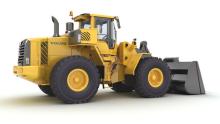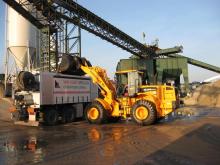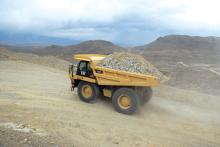
Need for higher breakout forces and limited working space is driving demand for larger excavators in European quarries. Claire Symes reports
While wheeled loaders can provide lower operating costs for face loading duties, narrow or high benches and need for greater breakout force mean that excavators are the best solution for some quarries. Nonetheless, the latest designs are helping to deliver better productivity with better fuel economy and higher efficiency than ever before.
Quarries using excavators appear to be continuing to invest in larger machines and the manufacturers are responding with larger models -
"Larger excavators are better for production and cost per tonne of production but the size of machines specified in European quarries is restricted by the size of trucks used," said Cat corporate account manager for quarries Vincent Migeotte. "Cat's new 374 and 390 excavators will help meet this demand for larger machines."
"Quarries are actively trying to reduce costs and some are trying to lower blasting costs with different patterns to meet outside constraints, so need the higher breakout force and strong structure of an excavator to cope.
"The blasting, truck size and processing all have an influence on the use of excavators but the main thing limiting the size of machines is the capacity of the primary crusher. But we are seeing investment in this area, so the upward trend in excavator sizes may well continue."
Fuel focus
The key drivers in the European excavator market are currently fuel efficiency, overall cost of ownership, reliability and productivity. According to Smith, hybrids are coming and will be at the forefront of technology but Hitachi's focus is on the productivity of the machine, and he believes that hybrid power may not be the best solution for larger machines.
Safety solutions
"Technological development in the last few years has focused on engines but future development is likely to be on reducing noise. Other safety development with ROPS/FOPS cabs has delivered a good level of equipment but there is more to come in the area of noise, I think. Nonetheless, I am sure we will get smarter when it comes to other safety features too," said Smith.
Customer demand is also driving safety developments at Cat and the walkway around the engine area on the new 374 is much larger than previous models and a larger cab gives improved visibility. But Migeotte said that Cat would continue to focus on further safety improvements.
Delue also cites adoption of ROPS cabs as standard as a major step forward in safety for quarries. "We also offer FOPS as an option, which does suit some quarrying applications," he said. "One cannot discount the productivity value of site safety either. It goes hand-in-hand that a safe quarry sees higher optimisation of the equipment, which in turn means an operator can gain maximum value from each day."
Resource management
According to both Migeotte and Smith, quarry operators can improve the productivity of excavators without investment in the latest technology. "Selecting the right work mode is essential," said Migeotte. "Latest electronics make this more intuitive but using the right mode can help improve economy." Smith added, "One of the main mistakes I often see is that operators do not fully understand all the machine variables and therefore do not use them fully. A good example is the different work modes available that allow the machine function to be tailored to the application." Driver training can also improve results and both Cat and Volvo offer programmes that focus on delivering productivity with economy. "Eco-drive training could also help operators to modify their driving to achieve better fuel economy by just making some small adjustments that would help reduce cycle times and wear," explained Migeotte.
He added that other small steps can also help improve operations on site. "Simple safety advice that is sometimes ignored include not loading from the blind side and careful positioning of the undercarriage to ensure the least strain on the machine," said Migeotte. "Operators and basic mistakes in layout can have a real influence on production and safety."









